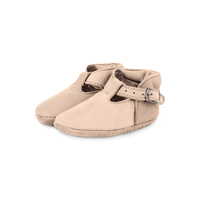 The Importance Of Quality Baby Shoes
The Importance Of Quality Baby Shoes
Date Posted:12 February 2018

If you have a child, you know that there’s nothing more important than their safety. And of course, you’ll want to start as early as you can, doing as much as you can. And what better place to start than with baby shoes? However, this is a tricky topic to get into, and you may have heard wildly different opinions from people on the best shoes for them to wear, as well as how early to start wearing them. However, this article will clear up all the confusion, so you can keep your baby safe in the best way possible.
A common thing to hear when you’re first shopping for baby shoes is that high-tops with rigid soles and uppers will help keep a child’s foot stable and well-positioned, but experts have found that when the child is younger, the opposite is truer. This is largely due to the fact that the bones in a baby’s foot are soft, and they usually don’t stop hardening until they’re about five years old.
It’s recommended that your baby should take his or her first steps barefoot, and you should keep them out of the shoes for a while after, as well. This is mainly to develop the bones and strengthen the muscles in their feet. Rigid shoes could constrict the feet, preventing the bones from proper development. They also make the baby’s feet heavier, which may throw off their balance and cause them to trip.
On the other hand, there are many benefits to going either barefoot or as close to it as possible. Aside from strengthening muscles and bones, going barefoot (or close to it) gives your baby the chance to develop their toe muscles by “gripping” the ground they walk on. To keep your baby’s feet clean and protected, doctors recommend that you use socks with rubber studs or grips on the soles, so the baby doesn’t slip.
However, at some point your child will spend more time outside, and you’ll want to buy shoes that can withstand the wear and tear of a newly-found walk against nature. In this case, the most important thing you can look at in baby shoes is the sole. Experts recommend thick rubber soles and you can twist and bend – this will help you give an idea of how they can stretch to the ways a toddler might move. In this case, rubber tends to beat out leather because they provide better traction. To best test the sole, bend it where the ball of the foot would be. If it bends easily, it’s good.
Other aspects to consider include the heel cap; the shoe’s height should go up to your child’s ankle, to provide support and stability for their ankles while walking. Your child should be able to slide easily and comfortably into the shoes, and they should have a comfortable, breathable inner lining.
And there should be a space between their foot and the shoes – at least half an inch. This is to allow for foot flattening during movement and changes in your child’s foot size: for children ages three and up, average foot growth is about one millimeter a month. When they’re younger, their foot grow even faster. And because of foot flattening – kids’ feet swell during the day just like adults’ – it’s a good idea to go shoe shopping around the end of the day, when your child’s feet are a little bigger than at the beginning.
To get an idea of size, it’s a good idea to make a template, which you can do by simply tracing your child’s foot on a piece of cardboard, add that suggested half inch we mentioned above, and cut it out so you can use it while you’re shopping. A lot of toddlers just learning to walk won’t tell you that the shoes they’re trying on may be too tight or chafing, so you’ll have to look for other ways they might indicate discomfort. Have them walk and run in their shoes at the shoe store – if they look uncomfortable at all, it might be the shoes.
Hopefully by now, you’ll have the basics down for baby shoe shopping. Of course, if your child has any foot-related medical conditions, you should consult your doctor before looking for shoes. And because of how fast their feet grow, it’s important to checking the shoe size as often as once a month. However, if you know what to look for, you should have little problem picking up quality shoes for your little one.





